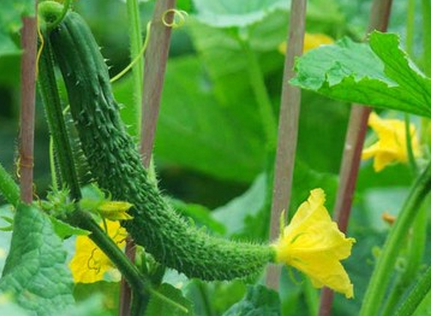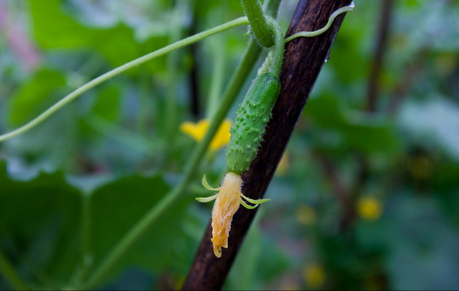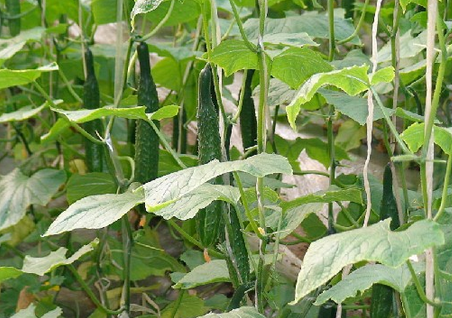Cucumber is sensitive to pesticides, and the dosage is relatively strict, especially the concentration and dosage of the seedlings should be strictly controlled. Improper medication can cause damage to cucumber plants and even cause plant death. The causes and protective measures of cucumber phytotoxicity are summarized as follows, so that the farmers can master the techniques of identifying phytotoxics and prevent them in time.

Silk flower phytotoxicity
In the cucumber melon period, the abuse of the melon is causing the phytotoxicity, and the plant can still grow, but the elongation is limited. The leaf margin of the directly damaged leaves is chlorotic and dry, and the leaf margin of the newly regenerated leaves is shallow and the leaves are nearly round. Affected by excessive chlormequat, the leaves of the melon seedlings are large, the stems are thick, the growth point is inhibited, and the elongation is not extended.
Treatment method
1 Seedling control Most cucumber varieties rely on low temperature to promote the differentiation and development of female flowers, especially at night. Generally, the daytime temperature is 25-30 °C, and the nighttime is 13-15 °C, which is favorable for female flower differentiation. Increase carbon dioxide, increase net photosynthetic rate, and increase female flowers. The use of grafted nursery female flowers has a low number of nodes and a large number, inhibiting vegetative growth and promoting reproductive growth.
2 Strengthen the management of phytotoxicity of fertilizer and water, according to the degree of phytotoxicity, increase the application of quick-acting nitrogen fertilizer, and increase the number of irrigation to ensure sufficient supply of water and fertilizer.
3 The temperature of the cucumber seedlings with normal temperature in the shed is 25-28 °C during the day and 13-15 °C during the night. After the damage, the shed temperature should be increased to 30 °C during the day to promote the growth of the seedlings, and the original low temperature can be maintained at night to ensure the continued differentiation of the female flowers.
4 spray gibberellin cucumber 4 leaves 1 heart phase treated with ethephon, the concentration of more than 200mg / L is the occurrence of phytotoxicity, at this time can be sprayed with 20 ~ 50mg / L gibberellin. At present, the gibberellin used is a crystal bagged product, which is first dissolved in alcohol or white wine and then prepared according to the concentration. It should be sprayed early after the symptoms of phytotoxicity appear, otherwise the effect will be poor. After the first interval of 1 week, the second time can be applied, and all of them can be restored to normal after 15 days.

Application of phytotoxicity
Large-dose pesticides and inferior sprayers run, run, drip, and leak, and large drops cause whitening and dryness of the seedling tip and excessive pesticide dripping spray to cause burning phenomenon. Due to multi-agent, multi-dose, high concentration or the drug itself, or the improper use of the plant leaves, the leaves of the plant are dry, and the leaves are dried up as the spray drops to the edge of the leaf.
Treatment method
1 If the damaged seedlings do not damage the growth point, they can strengthen the management of fertilizer and water and promote rapid growth.
2 After the occurrence of phytotoxicity, inhibition of growth, can spray 30 ~ 50mg / L gibberellin, and then with 100 times liquid sugar.
3 The blade appears to be rapidly twisted and sagging, and the white sugar can be sprayed 100 times immediately. Generally, the phytotoxicity can be quickly relieved.
4 small range of seedlings can be sprayed with gibberellin or with Kangkai 7500 times solution.

Drifting
symptom
Drifting phytotoxicity is often encountered in cucumber production. In the spring of the solanaceous fruit, the mist of the liquid drops inadvertently on the branches, stems and leaves of the cucumber in the greenhouse, and the fern leaves with suspected viral diseases are produced, and the young leaves are longitudinally distorted and deformed. Under the influence of the drifting agent airflow, the seedlings at the tuyere of the shed were firstly fumigated by the toxic gas, the growth of the plants was inhibited, the stems became thicker, the leaves stopped growing due to the damage of the mesophyll cells, and the leaves grew normally with the claw-shaped deformed leaves. The production of fern leaves or linear leaves is often misdiagnosed by vegetable farmers as a viral disease (farmers often referred to as "lobular disease").
Treatment method
1 spray water rinse can quickly spray the leaves with plenty of water when the early liquid has not fully penetrated or absorbed, and wash it repeatedly for 3 to 4 times, try to wash away the liquid on the surface of the plant, and cooperate with the cultivating loose soil to promote root development. To make the plants quickly return to normal growth.
2 foliar spray vegetable extract + plant multi-effect auxin.
3 Foliar application of 600-700 times of zinc sulfate to promote the production of imipenem by the plant itself, thereby relieving and slowing down the phytotoxicity.

Herbicide phytotoxicity
Symptoms of sulfonylurea herbicides causing phytotoxicity in cucumbers are: the plants in the frame are dwarfed, the growth is slow, and the new leaves are difficult to grow. Even if the new leaves grow, the color is yellow, the leaves become thinner, and the leaves appear on the leaves. Yellow spots isolated by veins, the leaves are brittle and easy to fall off; the flowers are thin and not strong, easy to fall off, and some die on the melons; the amount of fruit is small, the deformed melons are more, that is, the pointed mouth, the bee waist and the deformed melon. Change the taste, the value of the goods is poor. After the vines were opened, it was found that some of the brown liquid solution flowed to the roots. The roots had poor regeneration ability, and the lateral roots became thicker and shorter, and less. The growth potential of new leaves, flowers and fruits was weak and the yield was low. .
Treatment method
1 In the production, we should try to separate the herbicide from other pesticides and use the sprayer to avoid cross-medication.
2 The light-damaged plot immediately sprays poison and growth regulators, such as auxin, 10-20 mg/L gibberellin, cytokinin, and 4000-6000 times solution of Yunda 120 to prevent organ shedding and promote cells. Split and suppress aging.
3 Strengthen water and fertilizer management, use more foliar fertilizer and micro-fertilizer containing zinc and iron.
4 Vegetable fields with serious phytotoxicity can not be recovered normally, and can be immediately removed and replanted.
Black tea (dark tea) is named after the black appearance of the finished tea. It is one of the six major tea groups and is a post-fermented tea. The main production areas are Guangxi, Sichuan, Yunnan, Hubei, Hunan, Shaanxi and Anhui. The traditional black tea is made from high maturity black wool tea, which is the main raw material for pressing tightly pressed tea.
The process of making black tea generally includes four steps: killing, kneading, stacking and drying. Black tea is mainly classified as Hunan black tea (Fu tea, Qianliang tea, black brick tea, Tri-tip, etc.), Hubei green brick tea, Sichuan Tibetan tea (border tea), Anhui Gu Yi black tea (An tea), Yunnan black tea (Pu'er tea), Guangxi Liubao tea and Shaanxi black tea (Fu tea) according to geographical distribution.
The yellow powder in black tea is commonly known as golden flower, a beneficial microorganism, the so-called golden flower, is in the processing of raw materials through the flowering of this special procedure, specifically in the black tea bricks to cultivate a kind of coronary aspergillus substance called coronary scattered cystic bacteria, commonly known as the golden flower, observed under the microscope, each individual golden flower is umbrella-shaped clusters, the whole body is golden and eye-catching, ringed into a group, evenly distributed.
Yunnan black tea powder ; Hubei black brick tea powderï¼›Pu'er tea power
Shaanxi Zhongyi Kangjian Biotechnology Co.,Ltd , https://www.zyplantextract.com